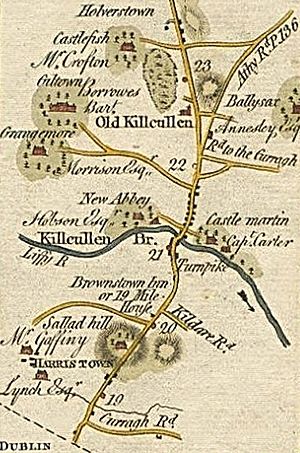Battle of Kilcullen facts for kids
Quick facts for kids Battle of Kilcullen |
|||||||
|---|---|---|---|---|---|---|---|
| Part of the United Irishmen Rebellion | |||||||
|
|||||||
| Belligerents | |||||||
| Commanders and leaders | |||||||
| Ralph Dundas | |||||||
| Strength | |||||||
| 200 -1,000 | 220 | ||||||
| Casualties and losses | |||||||
| c.150 | c.40 | ||||||
The Battle of Kilcullen happened on May 24, 1798. It took place near Kilcullen in County Kildare, Ireland. This battle was one of the first fights in the Irish Rebellion of 1798. It involved two separate clashes between Irish rebels and the British army.
Contents
First Fight: Old Kilcullen (7 a.m.)
The rebellion began on the night of May 23-24, 1798. There were attacks on nearby towns like Ballymore-Eustace, Naas, and Prosperous. As news of the uprising spread, rebels in Kilcullen gathered. They met in an old churchyard on a hill in Old Kilcullen.
Rebels Gather on the Hill
About 200 rebels were there by morning. Some had survived the attack on Ballymore-Eustace. Local British soldiers spotted them. These soldiers were led by Lieutenant General Ralph Dundas. His headquarters, Castle Martin, was only three miles away. Dundas quickly gathered about 120 soldiers. This group included infantry (foot soldiers), cavalry (soldiers on horseback), and dragoons (mounted infantry). They marched to break up the rebel gathering.
Cavalry Attack and Rebel Defense
About 80 cavalry and dragoons rode ahead. When they reached the bottom of the hill, they charged the rebels. But the rebels were ready. They quickly dug in using a ditch and the walls of the ruined church and graveyard. This protected them on three sides. The rebels used their long pikes to push back the cavalry. The cavalry lost over 30 men and many horses. Two of their captains died. One captain, Erskine, was reportedly killed after the battle. He had a broken leg from falling off his horse. An old woman found him and stabbed him with a rusty knife.
The rebels almost attacked the confused cavalry. But then the British infantry arrived. This allowed the surviving cavalry to retreat to Kilcullen Bridge. There, about 100 local yeomen (volunteer soldiers) joined them.
Second Fight: Kilcullen Turnpike (9 a.m.)
News of the British defeat spread quickly. The rebel army grew to almost 1,000 men. The rebel leaders decided to follow up their victory. They wanted to cut off the remaining British soldiers from the Dublin Road. This would stop communication between Dublin and the south. The rebels crossed the river Liffey downstream from Kilcullen Bridge. They then took over the high ground on both sides of the road at Turnpike Hill.
Dundas's Clever Plan
General Dundas now knew not to underestimate the rebels. He came up with a trick. He sent a small group of cavalry ahead. Their orders were to avoid fighting. Instead, they were to lure the rebels into a trap. The rebels fell for the trick. They chased the small group of cavalry. But then they were hit by many musket shots from waiting British soldiers.
When the rebels reached the Liffey, they were in disarray. The cavalry then attacked them. About 150 rebels were killed. The British reported no losses in this fight.
British Soldiers Pull Back
Even though Dundas won the second fight, he was worried. His earlier defeat, attacks on other small British groups, and news of the spreading rebellion shook him. As the commander of the army in the Midlands, he decided to make his position stronger. He ordered all his forces to pull back to Naas. This meant he was giving up much of the county to the rebels. In his rush to leave Kilcullen, some soldiers and wounded men were left behind. The rebels killed them.
Knockaulin (May 26)
The rebels who were defeated at Turnpike Hill gathered on Knockaulin hill. This is an ancient site called Dún Ailinne near Old Kilcullen. On Saturday, May 26, they started to talk about surrendering. Dundas was open to their offer of peace. The rebels then gave their terms. They would surrender their weapons and go home. But only if the British stopped taking over homes and returned stolen property.
Surrender Negotiations
Dundas was willing to negotiate and end the fighting. But the government was very angry. They sent General Gerard Lake, the army's Commander-in-Chief, to Castlemartin. By the time Lake arrived on Sunday, Dundas had agreed to a surrender the next day. This was Whit Monday. Patrick O'Kelly, a 17-year-old, was chosen to accept the surrender for the rebels. He was made a Colonel so he could properly deal with General Dundas.
The meeting was friendly. But Lake refused any terms. He demanded that the rebels fully surrender in the avenue of Castlemartin. O'Kelly said the rebels would only surrender on the hill. Despite Lake's objections, Dundas climbed Knockaulin.
Rebels Surrender Arms
Dundas's presence greatly calmed the rebels. They were disappointed that their terms were refused. But they began to put down their weapons and go home. According to O'Kelly, the pile of weapons was as big as the Royal Exchange. These weapons were later moved to Castlemartin. This surrender avoided a planned attack by General Lake. He had three regiments of infantry and four pieces of artillery ready to fight the rebels if needed.
Sources


